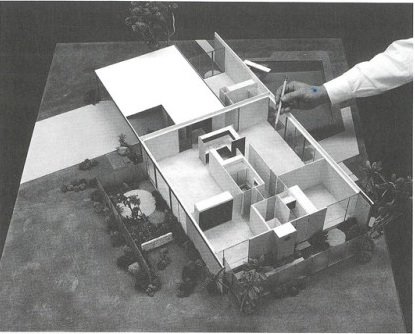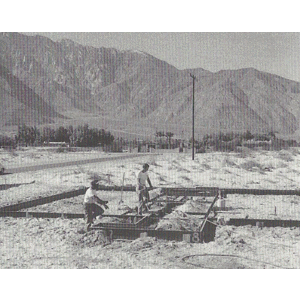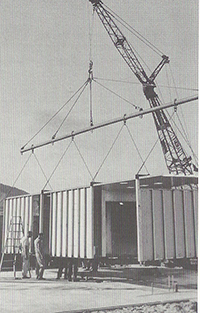Donald Wexler
Steel Homes History
 In 1962, the architects Donald Wexler and Ric Harrison introduced a novel all-steel system for the prefabrication of affordable houses suitable for the desert. The project was sponsored by US Steel, the structural engineer was Bernard Perlin of CalCor, and the builder was the Alexander Construction Company. The steel house tract was located in a remote windy part of Palm Springs, north of the newly built Riviera Hotel—surrounded on 3 sides by empty desert.
In 1962, the architects Donald Wexler and Ric Harrison introduced a novel all-steel system for the prefabrication of affordable houses suitable for the desert. The project was sponsored by US Steel, the structural engineer was Bernard Perlin of CalCor, and the builder was the Alexander Construction Company. The steel house tract was located in a remote windy part of Palm Springs, north of the newly built Riviera Hotel—surrounded on 3 sides by empty desert.
The houses were primarily composed of steel and glass—a unique combination of off-site and on-site assembly. Part of the genius of their approach was taking components that had been designed for the rapid construction of school classrooms and adapting them into stylish, custom-appearing houses for the middle class.
The wall modules consisted of an outer layer of light-gauge galvanized steel, a hollow core with gypsum board and fiberglass insulation, and drywall. The 9-by-36-foot central core of the house included the kitchen, two bathrooms, a laundry room, central hallway, and mechanical runs (electrical, ductwork, etc). Theses components were prefabricated in Los Angeles, trucked to the site, and lowered onto the slab by a crane. The outer rooms were then assembled around the core using the prefabricated steel panels, which were fit into a track template in the slab, interlocked, and bolted. The roof, also light-gauge steel, was then overlaid and bolted, supported both by the central core and the outer load-bearing steel panels. Each major room featured 8-foot-high sliding and stationary glass panels. Outer structural assembly took 3 days. The steel houses were impervious to heat, warping, rotting, swelling, termites, earthquake, and fire, and were very low maintenance.
core with gypsum board and fiberglass insulation, and drywall. The 9-by-36-foot central core of the house included the kitchen, two bathrooms, a laundry room, central hallway, and mechanical runs (electrical, ductwork, etc). Theses components were prefabricated in Los Angeles, trucked to the site, and lowered onto the slab by a crane. The outer rooms were then assembled around the core using the prefabricated steel panels, which were fit into a track template in the slab, interlocked, and bolted. The roof, also light-gauge steel, was then overlaid and bolted, supported both by the central core and the outer load-bearing steel panels. Each major room featured 8-foot-high sliding and stationary glass panels. Outer structural assembly took 3 days. The steel houses were impervious to heat, warping, rotting, swelling, termites, earthquake, and fire, and were very low maintenance.
 The first three of the seven houses (the models) were started in late 1961 and opened to the public in March of 1962, priced between $13,000 and $17,000. The models were furnished by noted designer Arthur Elrod. The planned tract of 38 all-steel houses were never completed due to the fact that shortly after the seven were built, the price of steel increased, decreasing the profit margin of the builder, who then cancelled the project. During the 1970s and 80s the houses were largely forgotten and fell into disrepair. Ultimately, the houses were rediscovered in the early 1990s and today—50 years later—six of the seven houses have been restored to their original appearance.
The first three of the seven houses (the models) were started in late 1961 and opened to the public in March of 1962, priced between $13,000 and $17,000. The models were furnished by noted designer Arthur Elrod. The planned tract of 38 all-steel houses were never completed due to the fact that shortly after the seven were built, the price of steel increased, decreasing the profit margin of the builder, who then cancelled the project. During the 1970s and 80s the houses were largely forgotten and fell into disrepair. Ultimately, the houses were rediscovered in the early 1990s and today—50 years later—six of the seven houses have been restored to their original appearance.
In 2001, the city of Palm Springs granted the seven steel houses Class 1 Historic Site status. In 2012, the US Department of the Interior listed Steel Development House No. 2 (3125 North Sunny View Drive) in the National Register of Historic Places, making it the first midcentury structure in Palm Springs to be so designated.


